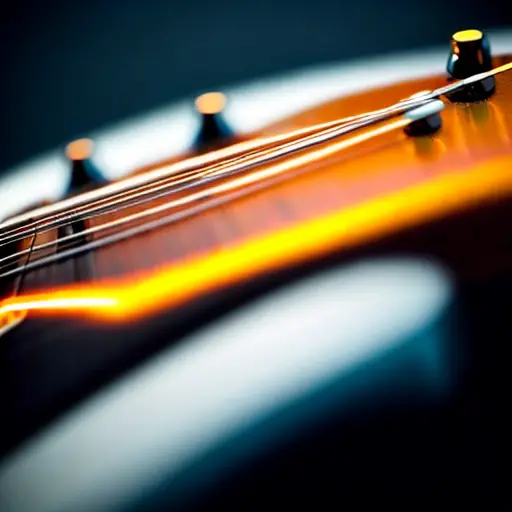Understanding the Basics of the Fretboard
So you've decided to tackle the mysterious beast known as the fretboard! First off, let's all take a moment to appreciate the fact that the word 'fret' sounds suspiciously close to 'threat,' which is exactly how it feels when you're faced with a sea of metal bars on your guitar. But fear not, my fellow aspiring guitar heroes! Learning the fretboard doesn't have to be as daunting as deciphering hieroglyphics written in ancient alien script. Sure, it may take a bit of time and practice, but once you unlock its secrets, you'll be able to navigate those frets like a boss. Trust me, you'll soon find yourself effortlessly shredding away like a true six-string ninja.
Mastering the Note Names and Intervals on the Fretboard
An interesting fact about learning the fretboard on a guitar is that renowned guitar virtuoso, Steve Vai, developed a unique method called the 'Vai 10-Hour Workout' specifically to help guitarists master the fretboard. This method involves practicing scales, chords, and arpeggios in a systematic manner for a total of ten hours. Vai claims that following this intensive regimen not only helps one understand the fretboard thoroughly, but also enhances creativity and improvisational skills on the guitar.
Ah, the mysterious fretboard, where guitar players embark on a never-ending quest to decipher its secret code. It's like trying to crack a ridiculously difficult Sudoku puzzle while blindfolded, with an octave of strings thrown in just to keep things interesting. But fear not, fellow music aficionados! If you're tired of playing 'guess the note' every time you pick up your guitar, it's time to embark on the epic adventure of mastering the note names and intervals on the fretboard. Picture this: you, armed with a pen, paper, and a mighty determination, braving the treacherous lands of scales, arpeggios, and mind-boggling finger patterns. No more playing in the dark and pretending you're just being 'artistic' – with this newfound knowledge, you'll be shredding those strings like a superhero armed with lightning bolts. So put on your cape, strap on your guitar, and prepare to conquer that almighty fretboard, one note at a time.
Building Musical Patterns and Memorizing Scales on the Fretboard

Alright folks, buckle up and grab your guitars, because today we are diving into the mystical realm of building musical patterns and memorizing scales on the fretboard. It's like trying to unravel a Rubik's Cube, while blindfolded, with your toes. But fear not, my fellow six-string enthusiasts, for we shall conquer this daunting task with a touch of humor and a sense of adventure.
First things first, let's talk about the fretboard. It's that delightful stretch of wood with metal wires on your guitar that loves to torment you like a mischievous little gremlin. But fear not, for we shall tame this beast together! Think of the fretboard as a map, and your fingers as tiny explorers on a quest for musical greatness. Get to know each fret as if it were a delightful little town, full of unique characters, vibrant colors, and yes, the occasional pothole (I'm looking at you, 13th fret).
Now, memorizing scales on the fretboard is a bit like memorizing your favorite pizza toppings. You start with the basics: pepperoni, tomato sauce, cheese. In our case, let's take the good ol' pentatonic scale. Think of it as the pepperoni of scales – the foundation upon which tastiness is built. Visualize the pattern on the fretboard, starting with the root note, and let your fingers follow the map. Practice it until your fingers know it so well, they could recite it in their sleep. And yes, they might actually dream about scales, don't judge them!
But wait, there's more! Now that you've conquered the pentatonic scale, let's spice things up with some additional toppings. Introducing the diatonic scale – the full-blown deluxe pizza of scales. It's got all the toppings, from pepperoni to mushrooms, onions, and even anchovies if you're feeling adventurous (not recommended for the faint-hearted). The diatonic scale is like a treasure hunt on the fretboard, where each note becomes a prized gem. Play it up and down the neck, experiment with different positions, and let your fingers dance amidst the melodic cheese and tomato sauce.
Now, the secret sauce to memorizing scales is repetition. Like trying to teach a dog to sit, you gotta repeat, repeat, and repeat some more. Play those scales until your fingers develop a muscle memory that rivals a concert pianist. And remember, don't rush the process. Learning the fretboard is a journey, not a race. Embrace the joys of exploration, the frustrations of wrong turns, and the triumphs of finally nailing that lick you've been practicing for weeks.
So, my fellow fretboard adventurers, grab your guitars and embark on this epic quest of musical patterns and memorizing scales. Embrace the laughter and the occasional frustrated scream when your fingers just won't cooperate. Remember, learning should be fun, even when it feels like unraveling a guitar-shaped Rubik's Cube. And with time, patience, and a dash of humor, you'll soon find yourself navigating the fretboard with confidence and a smile on your face. Now, let the fretboard exploration begin, and may the musical gods bless you with perfectly tuned strings and fingers full of rock and roll magic!
Implementing Effective Practice Techniques to Solidify Fretboard Knowledge
A fun fact about learning the fretboard on a guitar is that renowned guitarist and composer, Django Reinhardt, who is considered one of the greatest guitarists of all time, only had two functional fingers on his left hand. Despite this limitation, he mastered the fretboard by creating his own unique playing style. This is a reminder that with determination and creativity, anyone can learn to navigate the fretboard, regardless of any physical challenges they may face.
So, you want to learn the fretboard on guitar, huh? Well, get ready to embark on a magical journey filled with joy, frustration, and a few cramps in your fingers. But fear not, my fellow string strummers, for I am here to guide you with my wisdom and perhaps a sprinkling of humor. First off, let's talk about effective practice techniques. Sure, you could spend hours mindlessly running up and down the fretboard, but where's the fun in that? Instead, why not imagine your fretboard as a delicious pizza pie, with each fret representing a different topping? Pepperoni on the 3rd fret, anyone? Or maybe some extra cheese on the 12th? By creating weird associations like these, you'll solidify your fretboard knowledge in no time, all while making your stomach rumble. And hey, who said learning couldn't be cheesy?



